The following is a summary of our trip to Felshtin. On Tuesday, May 18, 2010, we visited Felshtin (now Hvardiyske). Our group consisted of Sid Shaievetz, his daughter Sondra Shaye, Mel Werbach and his wife, Gail, my wife, Fran Bernstein and myself. Our experiences in Gvardekoye, in L’viv, (known to our ancestors as Lemberg), and Khmelnitsky, formerly known as Proskurov, and at the dedication of the monument were fulfilling far beyond our expectations. At a later date, a more complete story of what took place, including photos and a video should be available on the Felshtin website. However, this will take time and we thought it important to share this brief version of our experiences with you now. We all felt strongly that this trip was an important moment in the history of the Society and that in spite of the large cost to us personally, in both time and money, extraordinarily worthwhile. We thank those who preceded us and showed us the way to reclaim our heritage. The pioneers that we are aware of include Mel & Gail Werbach, Rob Oksman, Steve Shaer, Harold and Sydelle Press.
Prior to our arrival, we had scant feedback as to what to expect from the town’s people, the school master, the students and government officials. Up to the date of our arrival, the only schedule that we were aware of was one we had communicated to our guide and translator, Alex Dunai. We had not received any communication from the school principal, Yuri Fedorov, the rabbi in Khemelnitsky or the synagogue sponsor, Igor Ratushny, despite numerous letters and emails. Alex had reassured us numerous times that the school principal was expecting us and prepared for our visit. He warned us not to be dismayed by the lack of confirmation for the events. He explained that this is the way things are done in Ukraine. Accepting this was not the easiest thing and it was hard not to be somewhat discouraged by the uncertainty of what would take place upon our arrival.
Our first surprise came late Monday afternoon when we arrived in Khmelnitsky. After four hours on the tortuous roads of Ukraine and even before going to our hotel (which requires a chapter by itself), we went to the local Jewish community center and discovered it to be under reconstruction. There, by chance, we ran into a lady who was on site to water the plants. Despite her seeming aloofness, she guided us to the local “Hesed Bescht.” In this ramshackle building that houses a community activity and help center, we were welcomed and discussed our mission with the volunteers we encountered. Fortunately, a reporter for the Jewish newspaper who happened to be present, agreed to escort us to the Kemilnitsky synagogue. After piling back into our van, we were guided to the synagogue. Although we had also made several efforts to communicate with both the rabbi and the synagogue founder, Mr. Ratushny, we had no indication that anyone had received our communications or had any interest in our presence.
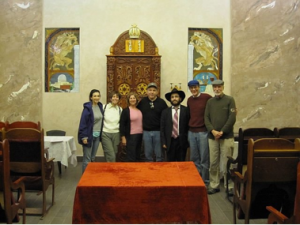
At the synagogue, we met Rabbi Raskin (pictured here third from right), who is a Chabad Lubavicher rabbi in charge of this completely restored building that houses a small but functional synagogue. Our encounter with Rabbi Raskin was nothing short of amazing. He was very happy to see us and show us around the synagogue and invited all of us, seven including Alex, to his home for dinner the following evening. He also agreed to meet us at to the memorial dedication and bring enough men from his congregation so that we would have a proper minyan.
The following morning, Tuesday, May 18, 2010, we proceeded to Felshtin, now known as Hvardiyske. We arrived there around noon and after a brief tour of the village, our guide, Alex, took us to the local school where we were warmly greeted by the Principal, Yuriy Fedorov, other school administrators and teachers. We met with them in a conference room for about an hour where we outlined the purpose of our visit. They listened with great interest and shared their understanding of life in Felshtin then and now. It was a very warm and open dialogue and we all felt very comfortable and welcome despite our need for translation of every word Sid Shaievitz presented Mr. Fedorov with a copy of his speech in Russian and two chapters from the Felshtin Memorial book that were translated into Russian. Mel Werbach presented Mr. Fedorov with a laminated enlargement of the layout of Felshtin taken from the memorial book.

While it seemed apparent from their demeanor and overt curiosity that the students were aware of our arrival and the nature of our visit, we were totally unprepared for what followed. We were led into a small auditorium where a group of 11 or so students from ages 9 to 17 presented a wonderful program of music and song welcoming us to the town and offering messages of friendship, love and peace. We were all overwhelmed by the experience. It took us completely by surprise and its heartfelt warmth spoke to our hearts in a way that our different languages were irrelevant.
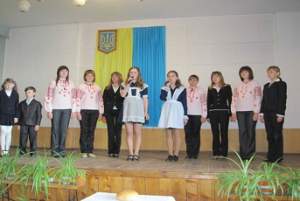
Additionally, the students had written a paper researching the history of the town that was presented to us. It is being translated at this time and will be published at a later date.
We then left for a guided tour of the town and to our dedication site. Hvardiyske, pronounced “Hvardeskye” in Ukranian, is a somewhat remote, rural farming town with probably no more than 500 people. Somewhat hilly and full of small lakes, the town is picturesque. We viewed the ruins of a synagogue and several houses that were once occupied by Jewish families. We walked and talked for about a half hour until time demanded that we pile into the van and proceed to the cemetery. Much to our surprise, our monument was not only intact but had been embellished with flower beds and a menorah. The monument site is in front of an ancient cemetery full of grave stones that are mostly buried. The site slopes toward one of those sweet little lakes that make the whole scene one of true bucolic beauty.
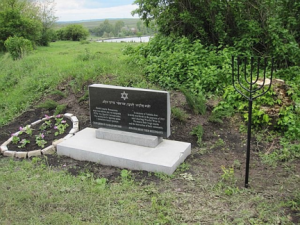
Before long, people began arriving on foot and by the time we began our ceremony, there were about 55 people in attendance. There were people from the school, a provincial administrator, various townspeople, the rabbi and congregants from Khmelnitsky, the reporter from the Khemelnitsky Jewish newspaper, in addition to our group. Suffice it to say, the presence of all the people made the entire event deeply and profoundly moving.
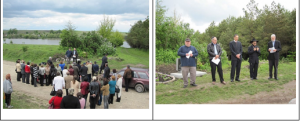
Having fulfilled our mission, we were invited back to the school for tea with Yuriy Fedorov and some of his staff. It was a wonderful exchange and we hope it created a framework of bonding and exchange for us to continue to maintain contact with these people and build on what we have begun.
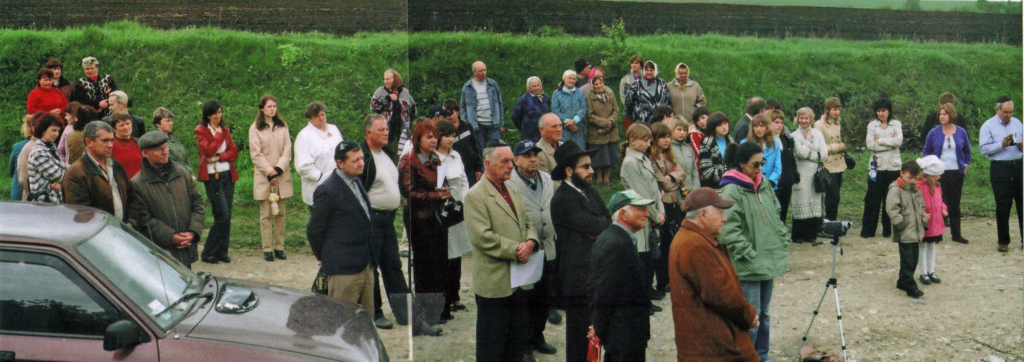
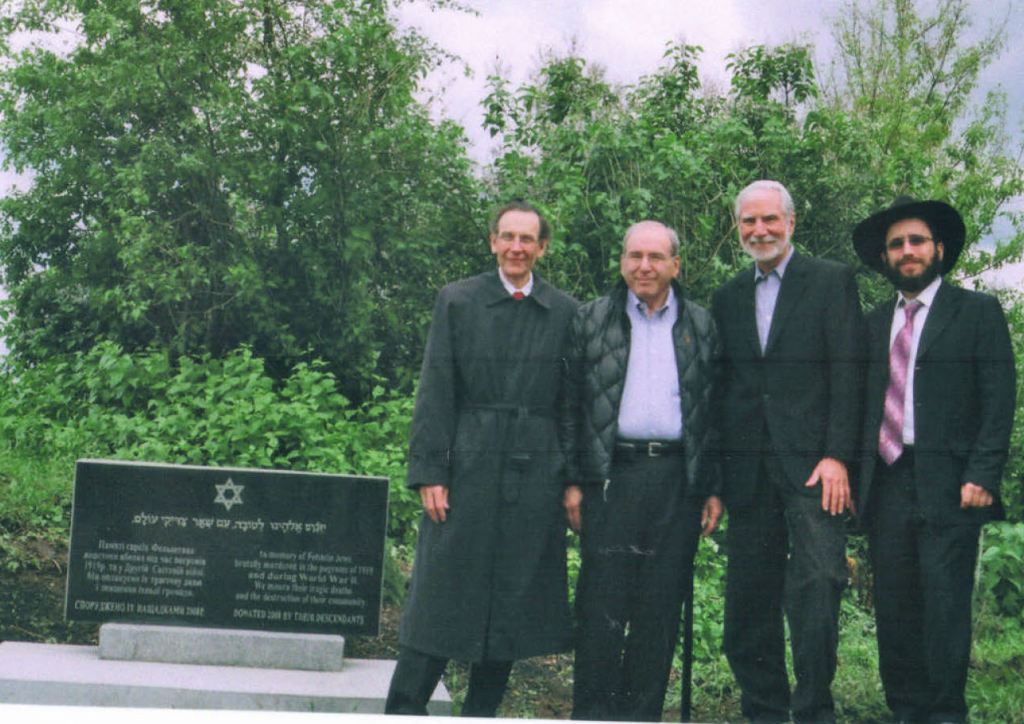
Standing alongside the memorial, from left to right, Sid
Shaievitz, Alan Bernstein, Mel Werbach and Rabbi
Yehoshua Raskin.
Our return to Khmelnitsky and L’viv was uneventful. Watching the large farms drift past the windows made it seem like you could be anywhere until we hit a pothole and got jolted back to reality. Ukraine is a poor country that has seen much more than its share of strife and disaster. We were treated well and with great pride and caring. We can never change the circumstances of why our predecessors left but we definitely returned in the right spirit. I appreciate all of the efforts of my travel mates, Sid, Sondra, Gail, Mel and Fran, who all pitched in to put this trip together and make it happen. We had a lot of fun, did our thing and became friends in the process. In my way of thinking, you can’t do better than that!
I thank all of the members who support what we do in word and deed. There is now more to do that I will outline shortly. We will once again ask for help from volunteers and I think we are ready with a new focus on our future activities. However, we still need people to pay the small amount of money we are asking for dues. If you can afford it, please do what you can to help us move things forward.
In friendship and with good wishes.
Alan Bernstein, President